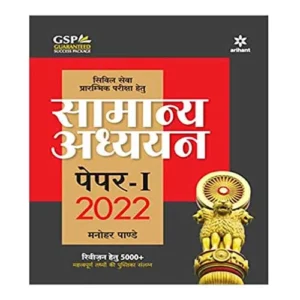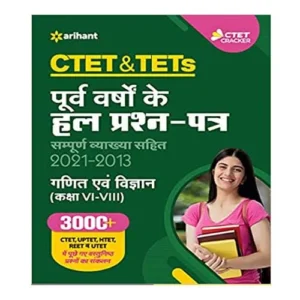Arihant NTA UGC NET SET JRF Shikshashastra Paper 2 Book In Hindi
Introduction
The “Arihant NTA UGC NET SET JRF Shikshashastra Paper 2 Book In Hindi” is a comprehensive guide designed to assist candidates preparing for the National Testing Agency’s University Grants Commission National Eligibility Test (NTA UGC NET) for the Junior Research Fellowship (JRF) and Assistant Professor eligibility in Education (Shikshashastra). This book is crafted by Arihant, a renowned name in educational publishing, known for its thorough and meticulously prepared study materials.
Alternative Names
To improve the SEO of your WordPress website, here are some alternative names by which this book can be identified:
- Arihant NTA UGC NET Shikshashastra Paper 2 Guide
- Arihant UGC NET Education Paper 2 Book in Hindi
- NTA NET JRF Education Paper 2 Arihant Book
- Arihant Shikshashastra Paper 2 NTA NET JRF
- UGC NET SET Shikshashastra Arihant Book in Hindi
- Arihant Shikshashastra Paper II for NTA NET
- UGC NET JRF Education Paper 2 Hindi Arihant
Overview of the Exam
The NTA UGC NET exam is a national level exam conducted to determine the eligibility of Indian nationals for the post of Assistant Professor or Junior Research Fellowship. The exam consists of two papers: Paper 1 (General Paper on Teaching & Research Aptitude) and Paper 2 (Subject-specific). Shikshashastra (Education) is one of the subjects for Paper 2, and it demands a deep understanding of educational theories, philosophies, and practices.
Book Structure and Content
Section 1: Theoretical Foundations of Education
- Philosophical Foundations: This section covers the philosophical underpinnings of education, including the contributions of various philosophers like Plato, Aristotle, Rousseau, Dewey, and Gandhi.
- Sociological Foundations: Discusses the social context of education, including the role of education in society, social stratification, and the impact of globalization on education.
- Psychological Foundations: Examines educational psychology, learning theories, motivation, intelligence, and the psychological principles that underlie effective teaching and learning.
Section 2: Educational Research and Statistics
- Research Methodology: Provides an overview of various research methods, including qualitative and quantitative approaches, experimental designs, and action research.
- Data Analysis and Interpretation: Covers statistical techniques for analyzing educational data, including descriptive and inferential statistics, hypothesis testing, and the use of software tools like SPSS.
Section 3: Educational Technology
- ICT in Education: Discusses the integration of Information and Communication Technology in education, e-learning, and the use of digital tools to enhance teaching and learning.
- Instructional Design: Explores the principles of designing effective instructional materials, multimedia learning, and the evaluation of educational software.
Section 4: Curriculum Studies
- Curriculum Development: Covers the principles and models of curriculum development, including the Tyler model, Taba model, and the Spiral curriculum.
- Curriculum Evaluation: Discusses various approaches to evaluating curricula, including formative and summative evaluation, and the use of rubrics and assessment tools.
Section 5: Educational Management and Leadership
- Educational Administration: Examines the theories and practices of educational administration, including leadership styles, decision-making processes, and organizational behavior.
- School Management: Discusses the management of educational institutions, including strategic planning, resource management, and quality assurance.
Section 6: Inclusive Education
- Special Education: Covers the principles and practices of inclusive education, including the education of children with special needs, and the implementation of inclusive practices in mainstream classrooms.
- Gender and Education: Examines gender issues in education, including gender equality, the role of education in women’s empowerment, and the challenges faced by girls in accessing education.
Section 7: Recent Developments in Education
- Educational Policies: Reviews recent educational policies and reforms, including the National Education Policy (NEP) 2020, and their implications for the education system.
- Global Trends in Education: Discusses global trends and innovations in education, including MOOCs, international assessments like PISA, and the impact of globalization on education.
Key Features of the Book
Comprehensive Coverage
The book provides exhaustive coverage of the syllabus prescribed for the NTA UGC NET Shikshashastra Paper 2 exam. Each topic is explained in detail, with a focus on conceptual clarity and practical application.
Practice Questions
At the end of each chapter, there are practice questions that mirror the format and difficulty level of the actual exam. These questions help candidates to test their understanding and prepare effectively for the exam.
Previous Years’ Papers
The book includes solved papers from previous years, providing candidates with insights into the exam pattern and the types of questions asked. This practice helps in identifying important topics and improving time management skills.
Model Papers
In addition to previous years’ papers, the book offers model papers designed according to the latest exam pattern. These papers provide a simulation of the actual exam, helping candidates to assess their readiness and improve their performance.
Detailed Explanations
Each question in the practice and model papers comes with detailed explanations. This feature helps candidates understand the reasoning behind the correct answers and learn the techniques to solve similar questions in the exam.
Easy to Understand Language
The book is written in simple and easy-to-understand Hindi, making it accessible to a wide range of candidates. The use of clear language ensures that complex concepts are explained in a way that is easy to grasp.
Updated Content
The content of the book is regularly updated to reflect the latest developments in the field of education and the changes in the exam pattern. This ensures that candidates have access to the most current and relevant information.
How to Use This Book
Create a Study Plan
- Assess Your Strengths and Weaknesses: Begin by identifying the topics you are strong in and those that require more attention. Use this assessment to create a study plan that allocates more time to your weaker areas.
- Set Realistic Goals: Set achievable study goals for each week. Break down the syllabus into manageable sections and focus on completing one section at a time.
- Regular Revision: Regularly revise the topics you have studied to reinforce your understanding and retain information. Use the practice questions and model papers for revision.
Practice Regularly
- Solve Practice Questions: Make it a habit to solve the practice questions at the end of each chapter. This will help you to reinforce your learning and identify areas where you need further clarification.
- Take Mock Tests: Regularly take the model papers under exam conditions. This will help you to improve your time management skills and build your confidence for the actual exam.
- Analyze Your Performance: After taking each mock test, analyze your performance to identify the topics you are struggling with. Focus on these areas in your subsequent study sessions.
Use Additional Resources
- Refer to Additional Books: While this book is comprehensive, referring to additional books on specific topics can provide you with a deeper understanding and different perspectives.
- Join Study Groups: Joining study groups can provide you with support and motivation. You can discuss difficult concepts with your peers and learn from their insights.
Stay Updated
- Follow Educational Journals: Reading educational journals and articles can help you stay updated with the latest trends and developments in the field of education.
- Attend Webinars and Workshops: Participating in webinars and workshops can provide you with additional knowledge and skills that can be useful for your exam preparation.
Conclusion
The “Arihant NTA UGC NET SET JRF Shikshashastra Paper 2 Book In Hindi” is an indispensable resource for candidates preparing for the NTA UGC NET exam in Education. With its comprehensive coverage, practice questions, solved papers, and detailed explanations, this book equips candidates with the knowledge and skills needed to succeed in the exam. By following a structured study plan, practicing regularly, and staying updated with the latest developments, candidates can maximize their chances of achieving their goal of qualifying for the Junior Research Fellowship and becoming eligible for the post of Assistant Professor.
FAQs
1. Who should use this book?
This book is ideal for candidates preparing for the NTA UGC NET exam in Shikshashastra (Education). It is also useful for those appearing for the SET exam and aiming for the Junior Research Fellowship (JRF) or eligibility for Assistant Professorship.
2. Is the book available in English?
No, this specific book is in Hindi. However, Arihant publishes similar books in English for the same exam.
3. Does the book cover the entire syllabus for Paper 2?
Yes, the book provides comprehensive coverage of the syllabus prescribed for the NTA UGC NET Shikshashastra Paper 2 exam.
4. Are the previous years’ papers included in the book?
Yes, the book includes solved papers from previous years, which helps candidates understand the exam pattern and types of questions asked.
5. How often is the book updated?
The book is regularly updated to reflect the latest developments in the field of education and changes in the exam pattern.
6. Can this book be used for self-study?
Yes, the book is designed for self-study. It includes detailed explanations, practice questions, and model papers to aid independent preparation.
7. Is there an online resource available with the book?
While the book itself is a comprehensive resource, candidates can supplement their preparation with online resources like educational websites, online courses, and webinars.
By following these guidelines and utilizing the “Arihant NTA UGC NET SET JRF Shikshashastra Paper 2 Book In Hindi” effectively, candidates can enhance their preparation and increase their chances of success in the NTA UGC NET exam
Subscribe to our YouTube channel for new updates on government jobs.








Reviews
There are no reviews yet.